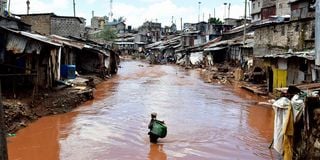New report spotlights extreme climatic events witnessed in 2023

A flooded Mathare River as it passes through Mathare Slums Gitathuru area.
What you need to know:
- Last year, Kenya endured a cruel sequence—months of drought followed by devastating floods that wreaked havoc across the country, with little time to recover in between.
Nearly everyone has witnessed a climatic event that stunned them in recent years. On platforms like TikTok, videos of homes being swept away by the raging floods of Hurricane Helene in Florida, United States, have gone viral.
Meanwhile, once teeming with life, Amazon River lies parched in places—its waters receding to reveal stretches of barren sand as relentless droughts fuelled by climate change take their toll on the water body.
But scientists say one need not look beyond borders to find such alarming events. Just last year, Kenya endured a cruel sequence—months of drought followed by devastating floods that wreaked havoc across the country, with little time to recover in between.
“I lost more than 20 cows from my herd of 50. And I had to sell six at a throwaway price because I could no longer feed them, and they were wasting away. When it rained in November last year, my village was affected. My homestead was marooned, so I decided to sell the remaining cows, again at a giveaway price,” says Mr Amos Ngiru, a resident of Kajiado.
A new report released this week by the Kenya Meteorological Department (KMD) assesses Kenya’s climate in 2023, spotlighting extreme weather patterns and putting them in the context of 1990-2020 climatology.
The researchers observed that many parts of Kenya experienced above-normal temperatures last year, mirroring a broader global trend. 2023 was recorded as the hottest year in history worldwide.
The study’s authors used data from the Climate Prediction Centre, revealing that Kenya has been warmer since 1979.
“In the late 1970s, average maximum temperatures in Kenya were generally around 29 degrees Celsius, but in the early 2020s, the average temperatures have risen to around 30.5 degrees Celsius,” reads the report.
Although the temperatures were averagely high, the authors note that some areas such as Central Highlands, Nairobi and isolated regions in the Southeastern lowlands (Ngong) experienced occasional low daytime temperatures that fell below 18 degrees Celsius.
It is anticipated that 2024 will likely match or exceed the temperatures observed in 2023 due to El Niño conditions and other anthropogenic factors. To avoid catastrophe, climate experts agree that the global temperature must be limited to 1.5 degrees Celsius, which was set out in the 2015 Paris Agreement.
If there’s one story that Kenyans will be telling for years to come, it’s the unpredictable nature of the rains that pounded most parts of the country in 2023 going into 2024. For the first time, Kenyans talked about a cyclone that felt dangerously close. The idea of Cyclone Hidaya brought fear across the country as communities braced for unpredictable winds and rains. Though it did not hit Kenya directly, the cyclone scare left many wondering about the future, fearing that such phenomena might become the new normal.
According to KMD, the severe storms that marked the country’s long rain season (March-April-May) were partly influenced by cyclone Freddy, the second-largest in terms of distance travelled, having covered more than 12,000 km and remained a tropical storm for 36 days, beating a record held by tropical John in 1994.
The coastal region experienced two days of extreme rainfall on November 15 and 16 in 2023, flooding in some places. According to the KMD report, Msabaha, Mombasa, and Mtwapa stations recorded more than 100 millimetres of rainfall on either day.
The heavy rainfall was part of the anomalies the scientists recorded last year. Western and central highlands and pockets of the northern region also recorded above-normal rain, as other parts of the country experienced dry conditions.
“In 2023, January and February were the driest months, while April and November were the wettest. The coastal and central highland regions were particularly wetter than normal across the year, ” reads the report.
As oceanic temperatures rise, scientists have warned that coastal structures, marine life and communities are under imminent threat. A 2021 study by different authors published in the journal Handbook of Climate Change Management notes that cultural heritage sites in Kilifi County are worsening, and the evidence is already showing through the emergence of cracks, collapse of walls and proliferation of plant life.
The Kenyan coastline covers nearly 600 kilometres and hosts towns like Malindi, Mombasa and Lamu.
“If you look at most hotels at the Coast, you will realise that many hotels or homes on the beachfront have built sea walls reinforced with rebar. The previous ones were eroded, and if we continue experiencing the kind of rainfall we did last year and part of this year, we might be out of business soon,” says John Mugendi, a hotelier in Mombasa County.
The report shows that in 2023, tidal heights were higher than the 1986-2001 average, with the highest tidal waves received in November and December. “We are highlighting the impacts experienced at the national level of weather and climate to support policy decisions,” offers Patricia Nying’uro, a climate scientist with Kenya Met and one of the lead authors of the report.
“The year 2023 provided ample evidence of how vulnerable developing countries like Kenya are bearing the brunt of climate change. It went on record as the hottest year in the instrumental record with global mean temperatures 1.48°C above the 1850-1900 level. This warming trend continues into 2024. Attribution science clearly indicates that the increasing intensity and frequency of extreme weather events in Kenya are driven by the ongoing warming of the planet, fuelled by emissions from coal, oil, and natural gas combustion. International concerted effort, particularly investment in adaptation, is critical to protect communities from escalating impacts and losses and damages,” said Dr Joyce Kimutai, a climate scientist with Kenya Met.
The researchers further underscore the socio-economic toll of the 2023 climatic events, painting a picture of destruction and strained resources. For instance, 757,173 people (138,560 households) were affected since the onset of the short rain season between October and December 2023.
By August 2023, more than 946,000 children under five years were reported to be acutely malnourished and close to 150,000 lactating women required urgent acute malnutrition treatment, according to a report by the Food Security and Nutrition Working Group.
The report further forecasts the outlook for the October-November-December (OND) 2024 ‘Short Rains’ season and shows that parts of the Western region will receive near to slightly above-average rainfall, while the central parts of the country and isolated areas over the northeast and southeastern lowlands are predicted to receive near to below average rainfall.
“The Coastal region, most of the Southeastern lowlands and Northeastern Kenya are expected to receive below-average rainfall. This will be driven by weak La Nina conditions, likely to develop from September to November and persist into early 2025 and a neutral Indian Ocean Dipole. The distribution is expected to be poor over most parts of the country, with prolonged dry spells and cases of isolated storms,” reads the report.
“We are doing our part to contribute to the global discourse on climate change, and we encourage closer linkages with national stakeholders in documenting the impacts of changing climate in various sectors,” offers David Gikungu, director KMD.





